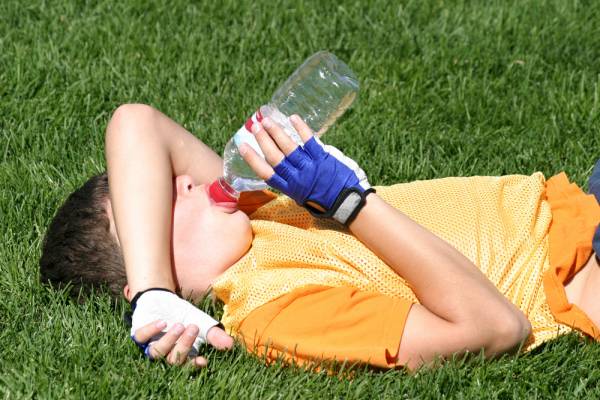Every parent, coach, and trainer knows that eating healthy while traveling is tough. Add the insatiable appetites of youth athletes into the equation, and it is easy to make unintended stops to fast food places, blowing healthy eating practices, as well as budgets, out of the water.
Every parent, coach, and trainer knows that eating healthy while traveling is tough. Add the insatiable appetites of youth athletes into the equation, and it is easy to make unintended stops to fast food places, blowing healthy eating practices, as well as budgets, out of the water.
With summer sports beginning and with travel weekend tournaments commonplace, it is important to be well prepared for properly fueling youth athletes.
Through personal experience, as well as through tried-and-true applications in working with clients, I have discovered what I call the “ABC” method of food preparation. This method is as simple and as easy as it gets, and more importantly, it is effective and efficient.
A = All Natural Food
In today’s society, the term “all natural food” is actually a contentious label. According to the FDA:
“…it is difficult to define a food product that is ‘natural’ because the food has probably been processed and is no longer the product of the earth. That said, FDA has not developed a definition for use of the term natural or its derivatives. However, the agency has not objected to the use of the term if the food does not contain added color, artificial flavors, or synthetic substances.”
Keeping that in mind, all natural food comes from nature and is not processed, or according to the FDA, is minimally processed. So, where does that leave a traveling athlete’s appetite? With fruits, vegetables, hard-boiled eggs, nuts, fish, and lean meats packed in a cooler.
No time to prepare for the weekend? You can apply the “A” of these same all natural food concepts to any restaurant, even a fast food restaurant.
As a coach and a trainer, as well as a mom, I have been witness to the fast food meal between games and competitions. I understand – sometimes fast food restaurants are all there is, but again, healthier choices can be made by applying the “A” to these restaurants.
Let’s take it a step further and see the effects of fast food on the athlete during competition. The fast food athlete (sometimes the whole team) drinks a soda and eats a burger and fries between games.
Within the first twenty minutes of drinking a soda and eating the fast food, the negative effects of the fast food begin taking place, internal to the athlete’s body.

When the fast food enters the athlete’s system, an insulin spike occurs and forces the liver to convert sugar into fat. Within forty minutes of the meal, the athlete’s blood pressure rises and the liver releases more sugar into the bloodstream.
At this point in the competition, there is little outward indication that the fast food has had any negative influence on the athlete’s performance, as the effects are still internal to the athlete’s body.
Between forty to sixty minutes post fast food consumption, however, athletic performance noticeably suffers.
Insulin levels drop dramatically and the athlete suffers from a sugar crash, leaving him or her drowsy and lethargic. Through proper food preparation and by applying the “A” of the ABC method of food preparation, you can help set your athlete up for a successful performance.
B = Beverages
While we know that water is essential for everyone, it becomes even more important to youth athletes in the summer months, when participating in all-day or weekend tournaments.
Water is necessary to cool the body, especially during exercise, when the athlete’s muscles generate heat, raising the body’s core temperature.
As this occurs, the body reacts by sweating. When sweat evaporates, the body cools. If the fluids lost through sweating are not replaced, the body cannot work properly to cool itself, leading to heat related injuries or illness.
While water is the first line of defense at maintaining the athlete’s hydration levels, it may be necessary to supplement water with electrolytes.
As applied to the “A” of the ABC food preparation method, electrolytes can be found in all natural foods, such as bananas, oranges, vegetables, sea weed, coconut water, and salt.
As mentioned previously, we already know the negative effects of soda on an athlete’s body, as well as on an athlete’s performance.
As with drinking soda, these same insulin spikes can occur with sugary sports drinks, caffeinated beverages, and performance drinks.

C = Consistency
In order to perform optimally, youth athletes need to maintain a consistently healthy diet. A diet rich in fruits, vegetables, lean sources of protein, healthy fats, and water are key to optimizing a young athlete’s health, growth, and performance.
While trying new foods is usually a good thing, it is not wise to try a new food before a tournament or competition. Again, nutritional consistency – the athlete continues to eat all natural foods for the tournament or competitions, just like the athlete does for practices. Nutrition is not a one-time occurrence.
Eating well right before the big game does not constitute good nutrition. Good nutrition comes from consistently making good choices about food.
What to eat, where to eat, how to eat? These are all good questions, with surprisingly many answers.
By using the basics of the ABC method of food preparation, and by personalizing it to an athlete’s needs, last minute fast food stops will be a thing of the past, and good nutrition and optimal athletic performance will be the norm.
References:
1. Daily Health Post. “This is What Happens in Your Body When you Drink a Coke.” Accessed June 2nd, 2014.
2. Reportlinker. “Food Industry: Market Research Reports, Statistics and Analysis.”Accessed June 2nd, 2014.
3. U.S. Food and Drug Administration. “FAQ newsletter.” Accessed June 2nd, 2014.
Photos courtesy of Shutterstock.






